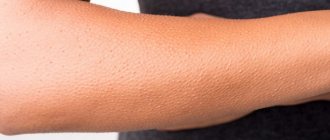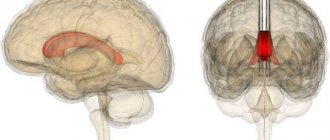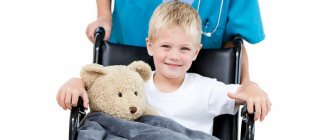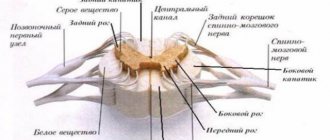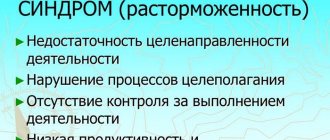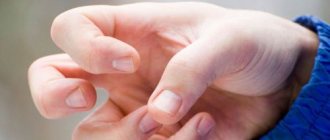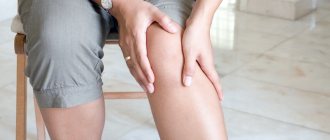Involuntary muscle contraction (myoclonus) is characterized by a sudden contraction of one or a group of muscle fibers. They occur in humans regardless of age, at rest or during movement.
This may be normal, but more often it is a consequence of a dysfunction of the nervous system. A therapist or neurologist will help determine the cause. The specialist will prescribe a medical examination, taking into account the diagnostic results, and select the most effective treatment.
Description
Considering the cause of involuntary muscle contraction, doctors distinguish the following types of pathological conditions:
| Name | Description |
| Physiological myoclonus | Appears in healthy people and does not require specific treatment:
|
| Essential | In most cases, the main reason is heredity. Seizures occur on their own, without accompanying symptoms. |
| Epileptic | Involuntary contractions occur against the background of an epileptic disorder. |
| Symptomatic (secondary) | The pathological condition develops due to the underlying disease:
|
Diagnostics will help determine the underlying cause or disease, after which the doctor will select the most effective treatment.
A muscle twitches on the arm: causes and treatment of diseases manifested by this symptom
The correct name for muscle twitching is fasciculation. This phenomenon has several causes, including both harmless and easily removable ones and very serious ones that require long-term treatment.
There is no specific diagnostic scale that describes the severity of fasciculations. Therefore, it is believed that if fasciculations occur occasionally, especially against the background of psycho-emotional and physical overload, then there is no need to worry.
However, if fasciculations become permanent, occurring daily or at regular intervals throughout the week, then a thorough examination by a doctor is required.
In any case, you need to thoroughly understand why the muscle in your arm twitches.
Common causes of twitching
These are phenomena that often occur in everyday life:
- emotions that are “off the charts” - quarrels, conflicts, suppressed discontent, hidden anger, anxiety, fears, melancholy, irritability, vain expectations, much more that human life is full of;
- physical overload, especially among unprepared people - country weekends, running for transport, climbing stairs to the upper floors, carrying heavy objects;
- hypothermia or overheating – there is an intensive consumption of electrolytes, especially potassium and magnesium, which causes twitching;
- drinking large quantities of alcohol, which disrupts all types of metabolism, including mineral and water;
- drinking energy drinks with a high caffeine content, which excessively irritates the nervous system;
- lack of protein when following strict diets or an unbalanced diet, when calories are “gained” from carbohydrates;
- insufficient water consumption.
The daily need for water is 30 ml per kilogram of body weight in cool weather and 50 ml per kilogram in hot weather.
Such causes often occur in healthy people and do not require treatment. All you need to do is eliminate the factor that caused the twitching. You need rest, normal sleep, nutrition balanced in essential substances, and enough water.
It is best to discuss emotional problems with your doctor. This is especially true for long-term traumatic problems - situations in the family or work team, when a person, due to objective circumstances, cannot leave the conflict zone.
The best help in such situations is a psychotherapist who explains to the patient the true state of affairs and helps to cope with what cannot be corrected.
Pathological causes
These are diseases in which neuromuscular transmission is disrupted:
- Parkinson's disease or shaking palsy;
- Huntington's disease or a hereditary disorder that causes jerking or chorea and mental problems;
- Tourette's syndrome or a genetic disease manifested by a variety of tics, including vocal or vocal ones, characteristic of childhood;
- Amyotrophic lateral sclerosis, or motor neuron disease, in which motor neurons undergo gradual degeneration, currently has no cure;
- progressive spinal atrophy or a group of hereditary diseases in which nerve cells slowly die;
- compression of the motor spinal nerve root, which often occurs with radiculitis and radiculoischemia;
- Isaacs syndrome or syndrome of constant activity of muscle fibers, most often caused by malignant tumors;
- a condition after a stroke, when involuntary muscle twitching occurs in a paralyzed limb;
- overdose of certain medications, especially anticholinergics and antibiotics;
- diseases of the thyroid gland, in which the hormonal regulation of homeostasis or the constancy of the internal environment of the body is disrupted;
- insect and poisonous snake bites.
It is impossible to independently determine the cause of fasciculations; a thorough examination is required, including tests for mineral content, electroneuromyography, neuroimaging and other methods.
In case of persistent fasciculations, when twitching moves from one muscle bundle to several muscles, as well as their constant repetition, you should not postpone a visit to a neurologist. Based on the clinical picture, one can with a high degree of probability assume one or another disease.
Many diseases of neuromuscular transmission can be successfully treated, although medications must be taken for a long time. The earlier treatment is started, the more successfully it is possible to stop the destruction of nerve structures.
Psychiatrist, psychotherapist Larisa Vladimirovna Neboga
Source: https://depressio.ru/nevrozy/470-dergaetsya-myshca-na-ruke.html
Symptoms
Involuntary muscle contraction (a neurologist or therapist will help determine the cause by prescribing diagnostic tests for the patient) is accompanied by characteristic clinical signs:
- wave-like stiffness of muscle tissue;
- aching or pressing painful sensations;
- spread of discomfort to other muscles;
- Partial or complete loss of control over the affected limb;
- a twisting sensation appears;
- severe muscle tightness, which is accompanied by acute pain when trying to unclench an arm or leg;
- muscle spasms compact the fibers, which can be seen with the naked eye;
- pain occurs when palpating the affected area;
- heart rate increases.
In some situations, involuntary muscle contraction affects the condition of the pupils.
Rarely, progressive pathological processes provoke the following symptoms:
- Loss of consciousness, after which in most cases epileptic seizures occur.
- Blurred consciousness, sound hallucinations. A symptom that also indicates the onset of an epileptic seizure.
If any signs appear, it is recommended to consult a doctor to undergo a full medical examination and begin timely treatment. Otherwise, there is a high probability of serious complications.
Etiology of the phenomenon
Why do muscles twitch? There are several reasons for this:
1. Psycho-emotional or physical stress. A stressful situation, a state of panic or anxiety, excessive physical activity, both long-term and short-term, lead to the fact that the human nervous system does not receive proper rest. This, in turn, causes so-called “nervous tics” to appear in various parts of the body, including the muscles of the legs and arms. Strong physical exertion sometimes leads to numbness of some tissues, which also contributes to their independent excitation, for example, when falling asleep. 2. Hypothermia of the body. 3. Toxic poisoning of the body or pathological effects of certain chemicals, especially frequent consumption of alcohol and energy drinks, which have a detrimental effect on the human nervous system, which causes the appearance of nervous tics in absolutely any part of the body. 4. Lack of certain vitamins and minerals in the body. Since the muscles of the human body are composed of protein and water, a lack of these substances can cause muscle spasm. 5. There are several quite serious pathologies, the symptoms of which can be muscle twitching in the arms or legs: Parkinson's and Huntington's diseases, Tourette's syndrome and ALS - amyotrophic lateral sclerosis. Some of these ailments are incurable, so muscle twitching in this case is practically impossible to correct.
Why does the arm twitch above or below the elbow? Fasciculations occur in almost every person and at completely different times: when falling asleep, after normal walking, while watching movies. There is not and cannot be an unambiguous answer to this question that is common to all situations that arise: for each person, the reasons for the appearance of this pathology can be completely different. The intensity, frequency and duration of muscle twitching become individual and depend only on the factor causing them.
The human body is a huge biological organism with multiple interconnections, the coordinated work of which ensures a calm, stable and natural course of all processes. But sometimes this powerful system fails. In some cases, while in a relaxed state, the muscles begin to twitch on their own. This not entirely normal state begins to bring a person a lot of reasons for concern - from surprise to some panic.
Many unmarried women sometimes experience the so-called “bride syndrome,” in which some muscles in various parts of the body suddenly begin to twitch or pulsate spontaneously: on the face, thigh, shoulder. This is the body’s physiological reaction to a protracted stressful situation, to anxiety and worry that “everyone around is already married.”
The most ordinary person constantly faces various situations in everyday life: chronic fatigue and lack of sleep, quarrels in the family and team, financial problems, sudden everyday issues, checks at work, studies or exams. An acute reaction to these phenomena leads to loosening of the nervous system and, as a result, involuntary contraction and twitching of some muscles.
Reasons for appearance
There are certain provoking factors against which pathological processes develop, leading to involuntary muscle contraction:
| Name | Description |
| Deficiency of nutrients and microelements | Muscles need protein and water. Otherwise, they weaken, causing spasms to appear. |
| Increased emotionality | As a result of severe stress and nervous tension, a person cannot get a good night's sleep. The functioning of the nervous system is disrupted, resulting in involuntary muscle contractions in various parts of the body. |
| Great physical activity | Muscles become overstrained, go numb and begin to twitch after intense training or hard work. |
| Temperature difference | Exposure to cold and hot air causes a sharp constriction of blood vessels, which causes muscle spasm. Systemic phenomena cannot be ignored; it is important to consult a doctor in a timely manner. |
| Standing for long periods of time | People more often experience cramps at night after a hard day of work. |
| Dehydration | Excessive sweating or loss of fluid leads to involuntary muscle contraction. |
| Uncomfortable position | Spasms are observed if you lie on one side for a long time with your leg slightly bent. |
| Use of certain medications | Medicines should be used strictly as prescribed by a doctor (antibiotics, diuretics, statins) or carefully read the instructions for use. The drugs cause side effects, including seizures. |
Involuntary muscle contraction (the cause and degree of pathological damage will be determined by diagnosis) occurs in people who worked hard during the day or were on their feet for a long time. The same applies to old people with diseases of the lower extremities. Convulsions in some cases occur in children when their body temperature rises.
Involuntary muscle contractions during neurosis
Neurosis is a real “disease of the 21st century”; the lifestyle of modern man contributes to the rapid spread of this pathology.
Neuroses or neurotic conditions are a large group of diseases of the nervous system that are psychogenic in nature.
And, although neurosis is not a threat to life, this illness can significantly worsen a person’s quality of life and create many problems for him in communicating with other people.
Despite the psychogenic nature of neurosis, there are also numerous vegetative symptoms of this disease. One of the most obvious and unpleasant signs of neurosis is an involuntary change in muscle tone: constant tension or periodic muscle twitching.
general description
Tics or muscle twitches are involuntary, periodic muscle twitches that can have different localizations.
Facial muscles and respiratory muscles can contract involuntarily (in this case, a person can make different sounds: coughing, squeaking, sighing heavily, suddenly interrupting his speech, which is reminiscent of stuttering symptoms).
There are also convulsive twitching of the muscles of the upper and lower extremities. Similar symptoms can occur in both children and adults.
It should be noted that it is not only neurosis that causes muscle twitching. Such symptoms may be the result of residual cerebral organic insufficiency, vegetative-vascular dystonia, alcoholism, drug addiction, epilepsy, schizophrenia or thyroid dysfunction. Only an experienced doctor can determine the exact cause of involuntary muscle contraction.
Another symptom that often causes neurosis is muscle tension. Just like muscle twitches, muscle tension can be caused by a variety of reasons. Pinched nerves (neuralgia) can also cause similar symptoms.
It can be cervical, thoracic and lumbar. The cause of this disease is compression of the spinal nerves as a result of various factors. Most often this is osteochondrosis of different parts of the spine.
However, other factors can also cause pinching.
Damage to the cranial nerves that innervate various muscle groups causes painful muscle tension. An example is neuritis of the facial nerve.
Psychoneuroses also cause excessive muscle tension, which often leads to poor posture. You can often see people whose movements are very stiff and similar to the movements of machinery. Psychologists have established a clear correlation between a person’s mental state and the tone of his muscles.
For example, increased tension in the arm muscles is often associated with increased aggressiveness, and muscle tension in the muscles of the pelvis and lower extremities is often associated with problems in the sexual sphere.
Causes
The cause of involuntary muscle contractions during neurosis is a state of restlessness, anxiety and fear, which are characteristic of a neurotic state. It is these reasons that lead to a state of mental arousal, which causes twitching and muscle spasms.
This was confirmed by the behavior of patients under the influence of suggestion or hypnosis. Muscle tics, like tension, are a kind of psychomotor release of accumulated painful internal tension.
Typically, people who experience such symptoms are highly emotional and vulnerable. At the same time, they try to keep their emotions deep within themselves. They are very sensitive to criticism and are emotionally unstable.
Very often, the cause of involuntary muscle contraction is hereditary factors; such symptoms are often passed on from parents to children. But genetic factors can only determine a predisposition to such symptoms. The main reason for their appearance is external factors and a person’s reaction to them.
Modern man lives a very stressful life. Constant rush, chronic lack of time, stressful situations negatively affect the functioning of the nervous system. In addition, in recent decades the number of people who are engaged in mental work has been constantly increasing.
A person living in a big city processes a huge amount of information every day, which also creates a significant load on the nervous system. All of the above factors lead to neuroses.
It should be remembered that involuntary muscle contractions are just one of the many symptoms of this disease. Here are the main causes of neurosis:
- Severe mental or physical stress associated with constant work, lack of normal rest (especially good sleep) for a long time. As a result, a person develops a state of constant (chronic) stress, which causes neurosis. Another reason for the occurrence of such symptoms may be personal experiences; both reasons together create a truly “hellish cocktail” and are almost guaranteed to lead to neurosis.
- Inability to correctly perform a certain task or achieve a set goal. A very common cause of neuroses that can cause involuntary muscle contractions.
- Also, such symptoms can be caused by a person’s reluctance or inability to rest. This schedule leads to nervous exhaustion and is one of the reasons for the onset of neurosis.
- Alcohol abuse or drug use. Such substances greatly deplete the nervous system and are one of the factors in the development of the disease. Very often people resort to alcohol in order to relieve nervous tension and relax. This is the wrong tactic. Alcohol weakens the nervous system and aggravates neurosis.
Treatment
The treatment for nervous muscle tension or involuntary twitching is to eliminate the cause that causes it. Because these signs are just symptoms of the disease. Treatment can be divided into two large groups: non-drug treatment and drug treatment.
The use of sedatives, tranquilizers and antidepressants allows the problem to be resolved (fully or partially). A doctor must prescribe medications; self-medication is unacceptable.
Psychotherapy is a fairly effective method of treating neuroses and eliminating unpleasant symptoms. However, this treatment method requires a lot of time and hard work from both the doctor and the patient.
In order to overcome the disease, the patient often needs to change his previous lifestyle: reduce daily stress, give up bad habits, learn to relate differently to life’s difficulties and adversities.
The people were taken aback! Joints will recover in 3 days! Attach...
Few people know, but this is exactly what heals joints in 7 days!
The patient’s attitude is very important, his desire to defeat the disease and free himself from it. This is a very difficult process, but it is impossible to defeat neurosis otherwise.
Most often, patients get rid of involuntary muscle contractions if it is caused precisely by neurotic conditions. But overcoming this problem can take quite a long time.
We recommend watching:
Source: https://lechenienevroza.ru/nevrozy/neproizvolnye-sokrashheniya-myshc.html
Diagnostics
A doctor will help you establish an accurate diagnosis, determine the provoking factor and prescribe therapy. It is important to go to the hospital when the first signs appear, undergo a full medical examination and begin treatment.
For diagnosis, patients are prescribed the following measures:
| Name | Description |
| Electroneurography | Short electrical impulses affect peripheral nerves, irritating them. The induced voltage will allow you to estimate the speed of nerve conduction. |
| Electromyography | The test helps measure the electrical activity of muscles. |
| Electroencephalography | A diagnostic method that evaluates the electrical activity of the brain. |
| Magnetic resonance imaging (MRI) | The study will determine brain damage and the development of malignant processes. |
To identify general abnormalities or diseases in the human body, he is prescribed a blood test, urine test, X-ray of the head, and computed tomography (CT). Blood vessels are also examined and allergy tests are performed.
Diagnostic measures
It is impossible to identify the cause of neurasthenia without the help of an experienced specialist. Frequent twitching of muscle structures in the knee joint, limbs and other areas of the body must be diagnosed using specially developed methods. Patients often delay consulting a doctor, explaining muscle twitching by lifestyle changes or other provocateurs. Advanced forms of fasciculation are more difficult to eliminate, so it is better to be examined in a timely manner.
The doctor begins the examination by collecting anamnesis. It is important for the patient to provide maximum information about sensations, accompanying symptoms, duration of attacks and their frequency. Next, the specialist prescribes the patient to undergo an X-ray or computed tomography scan. Manipulations help confirm or exclude the development of tumors and deformation in the skeletal structure.
When to see a doctor
It is necessary to visit a therapist if muscle cramps recur frequently. Consultation and diagnosis will help eliminate dangerous causes that can cause serious complications. A doctor's help will also be needed if severe painful spasms occur.
Involuntary muscle contraction (the causes may be a consequence of a heavy load on the body or a serious illness) is diagnosed and treated by a general practitioner. Considering the patient’s condition and the degree of damage to muscle tissue, the provoking source may also require consultation with other specialized specialists (neurologist, psychiatrist, narcologist, ophthalmologist).
Neurological or metabolic changes require careful medical evaluation. Based on the results, the doctor selects an effective treatment to restore material and fat metabolism.
What to do if muscles twitch on their own
If this problem occurs, first of all, it is worth analyzing the previous few days, if such twitching is of a one-time nature. If a few days before the onset of such a symptom there was severe stress, nervous tension, or a psycho-emotional state, then you need to rest well, do breathing exercises, and such twitching will disappear on its own.
If there are chronic diseases, such twitching may be associated with their exacerbations or the general course of the disease. In this case, it is necessary to contact, first of all, a therapist, who will identify a specialist who is competent to answer the question of why twitching occurs and how to eliminate it.
After consulting a therapist, the cause of twitching can be determined as vitamin deficiency, namely, insufficient levels of potassium and iron in the blood. In this case, the most effective treatment will be vitamin therapy and taking special medications.
If there is a constant or prolonged twitching of a muscle, you should definitely examine the vascular system: do an electro- or tomographic study of the brain, which will give answers to the questions: what is it - a pinched nerve or insufficient blood circulation to the brain, which in turn can cause involuntary twitching muscles of various parts of the body.
If twitching of the muscles of the arms and legs occurs after prolonged strength exercises, first of all, you need to eliminate physical activity and give the muscles a rest. Twitching of this type, as a rule, goes away on its own within a few days and does not recur.
Prevention
Involuntary muscle contractions can be prevented if you follow the therapist’s recommendations, even after full treatment. The risk of relapse always remains.
For prevention, you should remember the following rules:
- Eat a balanced diet to constantly maintain the required level of microelements and vitamins in the body.
- Eliminate bad habits from your life, including the abuse of alcoholic beverages, cigarettes and narcotic substances.
- Wear comfortable shoes and loose clothing to prevent muscle tightness.
- Strictly adhere to the work and rest schedule.
- Avoid stress at work and at home, control your emotions.
- At the first symptoms or suspicions, consult a doctor for timely treatment.
- Take a contrast shower. Water treatments for your feet will help prevent night cramps. A contrast shower has a positive effect on blood circulation.
A preventative trip to the hospital will also help prevent muscle cramps. It is recommended to monitor your weight and get rid of extra pounds, which put a lot of stress on the lower limbs and muscles.
Twitching biceps on right arm
› Drugs
29.01.2020
The correct name for muscle twitching is fasciculation. This phenomenon has several causes, including both harmless and easily removable ones and very serious ones that require long-term treatment.
There is no specific diagnostic scale that describes the severity of fasciculations. Therefore, it is believed that if fasciculations occur occasionally, especially against the background of psycho-emotional and physical overload, then there is no need to worry.
However, if fasciculations become permanent, occurring daily or at regular intervals throughout the week, then a thorough examination by a doctor is required.
In any case, you need to thoroughly understand why the muscle in your arm twitches.
Why does the muscle on the arm above the elbow twitch?
It is important to know! Doctors are shocked: “An effective and affordable remedy for joint pain exists. " Read more.
Elastic muscle tissue contracts under the influence of nerve impulses. Thanks to muscles, a person is able to perform various movements. It happens that an involuntary muscle contraction occurs, and the arm twitches above the elbow.
Necessary measures
If you are bothered by twitching and pulsation in your arm near the elbow, you should seek medical help. If the doctor, after examination and additional examination, excludes serious pathologies, then you can cope with the problem by following the following recommendations:
- Adjust your diet. The daily menu should contain products containing the microelements and vitamins necessary for the body. You need to drink more plain water without carbon.
- When performing work of a mental or physical nature, you need to take frequent breaks to rest.
- Quality sleep is important.
- Pharmaceutical compositions of herbal origin and breathing exercises will help get rid of nervous tension.
There are a number of rules to help you quickly deal with pulsation in the arm localized above the elbow:
- You need to drink a glass of drinking water without gas. A cup of brewed chamomile helps you calm down. You can add a spoonful of honey to the water and chamomile infusion. Drinking chamomile infusion daily will calm nerve cells.
- Get used to daily walks in any weather. It's good if you can take a walk before bed.
- Learn to breathe correctly. A few leisurely, deep breaths will saturate the tissues with oxygen and help suppress involuntary nerve impulses that cause muscle twitching.
Muscle pulsation and twitching refers to the body's response to various stressful situations. Thus, the body can signal about malfunctions of the nervous system. The phenomenon is not life-threatening and often stops on its own. But before you start making lifestyle changes, you should definitely consult your doctor.
How to forget about joint pain forever?
Have you ever experienced unbearable joint pain or constant back pain? Judging by the fact that you are reading this article, you are already familiar with them personally. And, of course, you know firsthand what it is:
- constant aching and sharp pain;
- inability to move comfortably and easily;
- constant tension in the back muscles;
- unpleasant crunching and clicking in the joints;
- sharp shooting in the spine or causeless pain in the joints;
- inability to sit in one position for a long time.
Now answer the question: are you satisfied with this? Can such pain be tolerated? How much money have you already spent on ineffective treatment? That's right - it's time to end this! Do you agree? That is why we decided to publish an exclusive interview in which the secrets of getting rid of joint and back pain are revealed. Read more.
The biceps on the right arm twitches Link to main publication
Source: https://diapazonmed.ru/preparaty/dergaetsya-bitseps-na-pravoj-ruke.html
Treatment methods
Involuntary muscle contraction (the causes are important to establish at an early stage in the development of pathological processes in order to prevent complications) is treated with complex methods. You should not engage in self-therapy, as this can cause negative consequences.
Traditional medications help eliminate muscle cramps. If there are no serious contraindications, there is no individual sensitivity, you can use traditional medicine.
Medications
Medicines are prescribed by a general practitioner after a full medical examination based on the results obtained. You should not take medications on your own, as they may cause side effects. Medicines are selected by a specialist, taking into account the patient’s condition, the degree of development of pathological processes and the individual characteristics of the body.
| Group of drugs | Name | Application |
| Anticonvulsants | Carbamazepine, Phenobarbital | The medicine is taken orally with plenty of water. The recommended dosage for adults is 100-200 mg 1-2 times a day. |
| Painkillers | Ketanov, Ketorolac | Adults are prescribed 10 mg every 4-6 hours. For severe pain, the dosage is 20 mg 3-4 times a day. |
| Antispasmodics | Spazmalgon, Papaverine | Adults are recommended to take the drug after meals, 1-2 tablets 2-3 times a day. The duration of therapy lasts 5 days. |
| Muscle relaxants | Mydocalm, Baclofen | The adult dosage is 50-150 mg 2-3 times a day. |
| Nonsteroidal anti-inflammatory drugs | Ibuprofen, Diclofenac | Adults are prescribed 1 capsule 3-4 times a day with an interval of 6-8 hours. |
Baclofen (baclosan) is a muscle relaxant for relieving muscle spasms during involuntary contractions and a GABA-B agonist.
Additionally, the patient is prescribed a special complex of multivitamins to replenish potassium and magnesium levels (Asparkam, Complivit).
Traditional methods
Recipes from healers and healers can also be used for involuntary muscle contractions, but strictly after consultation with a general practitioner. Many herbs and natural ingredients used can trigger an allergic reaction or aggravate health conditions.
| Name | Recipe | Application |
| Poppy flowers | Grind the main component to a powder. Pour 1 tbsp. flowers with milk (20 tbsp) and add a small amount of natural honey. | It is recommended to use the finished product 3 times a day, 1 tbsp. |
| Healing ointment | Mix egg yolk with 1 tbsp. turpentine and 1 tbsp. apple cider vinegar. | The resulting product is used for external use, and the affected muscles are rubbed. |
| Birch buds | Dried buds (2 tbsp) pour boiling water (200 ml). Leave for 1 hour and strain. | Take 3 tablespoons of the finished product. every day. |
Lemon juice helps eliminate involuntary muscle contractions. It is rubbed into the affected area of the body, left until dry and wrapped in a warm cloth. It is recommended to carry out the procedure before bedtime.
Other methods
The fight against involuntary muscle contractions involves not only taking medications, but also attending physiotherapeutic procedures:
| Name | Description |
| Magnetic therapy | Treatment reduces spasm and improves trophism of the affected muscles, prevents blood stagnation and spastic phenomena. |
| Electrophoresis | The medicine allows you to relax your muscles and relieve tissue spasms. |
| Acupuncture | Acupressure improves blood circulation. The conductivity of nerve impulses is restored. |
| Hirudotherapy | Leeches improve blood circulation and reduce ischemia of affected tissues. |
Massage procedures have a positive effect on muscles, improving trophism, relaxing them, reducing swelling and pain.
Involuntary muscle contraction must be treated comprehensively, following a certain diet. One of the reasons for seizures is a lack of vitamins and microelements.
Special dietary nutrition will help compensate for the deficiency of the following substances:
| Name | Description |
| Phosphorus | Supports the functioning of the central nervous system, which takes part in the functioning of muscle tissue. Phosphorus is contained in large quantities in sea fish and dairy products. |
| Potassium | The trace element is responsible for the operation of the cellular pump, which removes excess fluid from the human body. To replenish potassium reserves, it is recommended to consume more fresh vegetables and fruits. |
| Magnesium | Dilates blood vessels and is guaranteed to eliminate spasms. Coffee and alcoholic drinks, as well as diuretics, flush the element from the human body. Calcium levels increase, causing involuntary muscle cramps. To replenish magnesium, it is recommended to consume more whole grains, sesame seeds and natural cocoa. |
| Vitamin D | The element supports the functioning of the digestive system. Promotes the absorption of potassium, phosphorus and magnesium in the intestines. The vitamin also helps restore calcium levels in blood vessels. Found in yeast, algae and oily fish. |
It is important not only to properly plan your diet, but also to adhere to a healthy lifestyle. Give up any bad habits (cigarettes, alcohol, drugs). Instead of tea, drink herbal drinks. Engage in moderate physical activity and stretch your muscles.
If there is no positive effect after drug treatment or if the brain or spinal cord is affected by a tumor, patients are indicated for surgical intervention.
The muscle in the arm above the elbow twitches: causes of pulsation, why does the arm pulsate?
Muscle twitching is an involuntary contraction of a muscle group that receives an impulse from a motor neuron.
In situations where the phenomenon occurs once, a person does not have to worry about the state of his health. However, if muscle twitching occurs regularly, then it will be important to undergo a medical examination.
With its help, you will be able to roughly understand what exactly is happening to a specific person.
Only a doctor can definitely say why muscle twitching occurs throughout the body; the reasons are very different.
Features of neuromuscular transmission
In order to contract muscle fibers, an impulse from the nervous system is required. The main section from which the impulse comes is the motor neuron. This is a cell located in the region of the anterior horns of the spinal cord on the left and right sides.
Between this structure and the muscle fiber there is a synapse, or synaptic cleft. Such a department is necessary to connect the above structures.
They transmit nerve impulses through the production of specific chemicals. The most popular biological substance is acetylcholine. It is synthesized continuously.
The remaining acetylcholine is broken down by the enzyme acetylcholinesterase.
Consequences and complications of convulsive conditions
Based on the studied general and individual causes of muscle twitching, possible complications can be identified:
- developmental defects, metabolic disorders in children under 2 years of age; idiopathic epilepsy – children from 2 to 14 years;
- tumors, strokes, attacks of loss of consciousness, long-term treatment with anticonvulsants - in adults.
Also a significant consequence is surgical intervention, which is prescribed in cases where anticonvulsants do not control the frequency of seizures.
Physiological reasons
Among the reasons that cause the development of muscle contractions in the arm, there are two groups of conditions. Based on these factors, treatment and preventive measures are selected.
Important! The following conditions may occur in a patient in everyday life.
Most often, the muscle on the arm above the elbow or above the knee twitches during emotional excitement, accompanied by anger, fear, anxiety, melancholy, and irritability. Overstrain of the nervous system develops over a long period of time, causing its exhaustion, as well as acutely.
The natural cause is excessive physical activity in a person with an undeveloped muscular system. Provoking factors include long climbs up stairs, working in summer cottages, and carrying heavy loads. Among the manifestations, one can identify how the muscle on the leg twitches above the knee or up to the elbow.
Exposure to physical factors, such as hypothermia or overheating. As a result of a change in temperature, electrolyte metabolism is disrupted with excessive consumption of components such as potassium and magnesium.
In socially disadvantaged individuals and patients who abuse diets, muscle twitching develops against the background of excessive protein consumption at rest.
This manifestation is caused by insufficient intake from food, as well as tissue destruction. Energy from protein molecules is spent on vital processes.
In addition, twitching appears due to a small intake of water into the body, which provokes its release from the cells and dehydration.
Preventive actions
In the life of a modern person there are many factors that can provoke the appearance of osteochondrosis. It is impossible to exclude all harmful effects, but following the proposed recommendations will reduce the likelihood of developing the disease:
- Correct posture. This will ensure an even load on the spinal column.
- Complete rest. A tired person tenses the muscles of the body, the back slouches, and this leads to pressure on some areas of the intervertebral discs.
- Avoid prolonged immobility. If you need to drive a car or work at a computer for a long time, you should take short breaks for active rest.
- Exercise. Extensive physical activity is undesirable; swimming, yoga or therapeutic exercises would be optimal.
Pathological
Why do my back muscles hurt?
Muscle twitching in the arm area develops against the background of diseases accompanied by impaired transmission of neuromuscular impulses. They may have hereditary or acquired causes. Among the most common pathological causes are Parkinson's or Huntington's disease.
The conditions are steadily progressive and are associated with the death of nerve cells in the brain and spinal cord. The diseases are accompanied by the appearance of muscle weakness and tremors in certain groups.
When they form, a gradual deterioration in well-being occurs with increased twitching.
Tutter syndrome. A genetic pathology that occurs from birth is accompanied by the appearance of nerve contractions in the limbs of the shoulder, arms or legs, as well as tics. These symptoms are most worrisome in children.
Amyotrophic lateral sclerosis, spinal atrophy, and neuronal death as a result of long-term alcohol consumption. Such conditions are accompanied by the development of involuntary muscle contraction due to disruption of the functioning of individual synapses with a simultaneous increase in the work of neighboring fibers.
Isaacs syndrome. The disease is caused by the steady growth of a malignant tumor and is accompanied by excessive functional muscle activity, which occurs throughout the body.
Overactive thyroid gland. Toxic effects due to an overdose of medications, which include anticholinergics or antibiotics, as well as the bite of poisonous insects or snakes.
Source: https://neuro-orto.ru/simptomy/dergaetsya-myshca-na-ruke.html
Possible complications
In the absence of timely therapy, progressive pathological processes entail serious consequences:
- pinched nerve;
- muscle tension increases;
- blood circulation is impaired if involuntary muscle contraction is caused by vegetative-vascular dystonia;
- severe cramps or partial loss of sensitivity due to heavy physical exertion.
In some situations, the integrity and functioning of muscle tissue is disrupted, and cardiac arrhythmia occurs. Unbearable pain leads to a person falling and receiving various injuries.
Involuntary muscle contractions occur in people at any age. The severity and frequency of attacks depends on the provoking factor, the underlying cause.
The first manifestations should not be ignored, as they may indicate the development of a serious disease. It is important to undergo a timely examination, establish an accurate diagnosis and begin treatment. Otherwise, there is a high probability of serious consequences.
Article design: Vladimir the Great
Nervous tic
Have you been trying to heal your JOINTS for many years?
Head of the Institute for the Treatment of Joints: “You will be amazed at how easy it is to cure your joints by taking the product every day for 147 rubles ...
Read more "
A nervous tic is a muscle contraction that is arrhythmic and involuntary. It can be temporary or permanent. The temporary effect can be caused by strong feelings, fear or a pinched nerve. And a permanent tic is formed due to a lack of microelements after illnesses. Types of nervous tics and hyperkinesis: – Teeth grinding. - Twitching of the wings of the nose. – Brief twitching of the muscles of the limbs. - Shaking head. – Nervous tic from hyperkinesis in sleep.
Ticks are also divided depending on their location: – Local tics manifest themselves in the contraction of one muscle group. – A generalized tic combines the simultaneous contraction of several groups at once, and at the same time they begin and stop simultaneously.

